All products featured are independently chosen by us. However, SoundGuys may receive a commission on orders placed through its retail links. See our ethics statement.
Samsung Galaxy Buds Pro vs Sony WF-1000XM4
Published onOctober 5, 2023



One of the best pairs of active noise canceling (ANC) true wireless earbuds, the Sony WF-1000XM3, finally has a younger sibling. The new Sony WF-1000XM4 is already making a name for itself with great noise canceling performance and Bluetooth 5.2, but how does it compare to other 2021 releases?
Today we’re doing a side-by-side comparison of the Sony WF-1000XM4 and the Samsung Galaxy Buds Pro, two pairs of ANC true wireless earbuds hot off the presses.
Editor’s note: this post was updated on October 5, 2023, to add information about the Samsung Galaxy Buds 2 Pro, Sony WF-1000XM5, to update charts, and format.
The Samsung Galaxy Buds Pro have been discontinued, and superseded by the Samsung Galaxy Buds 2 Pro. The Sony WF-1000XM4 have been superseded by the Sony WF-1000XM5. We compare them both.
Does the Samsung Galaxy Buds Pro or Sony WF-1000XM4 have a better design?
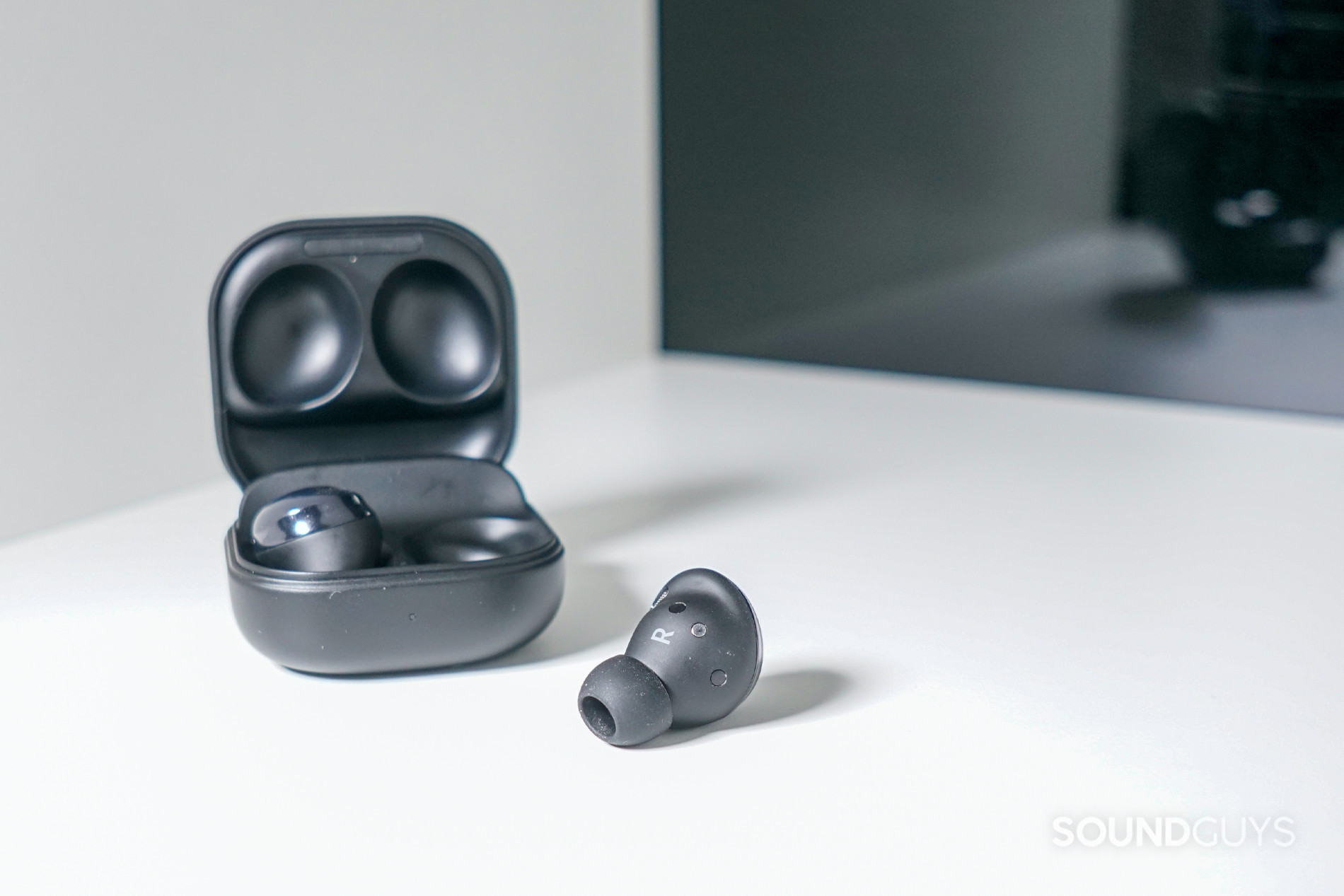
The Sony WF-1000XM4 comes in fully recyclable packaging, which is a nice gesture considering the short-lived batteries of true wireless earbuds are nightmares for environmentalists. The buds have an IPX4 rating, so they fit right in at the gym, so long as you find a stable fit with the foam ear tips. If you’re unsure of how to find the best ear tips, just open the Sony Headphones Connect app’s ear tip fit test. This headset’s design is sleek and unique, and though its case is a little bulky, it should fit in most pockets. These buds feature touch pads on each earbud for on-ear control, and they support automatic pause and play.
Where the Sony WF-1000XM4 has a matte covering, the Samsung Galaxy Buds Pro has a reflective coating. It also features touch controls, though the buds are hypersensitive and register accidental touches quite often. The Samsung earbuds come with silicone ear tips, rather than foam ones, and stabilizing fins to keep a secure fit, though there’s no way to check that in the Galaxy Wearable app. The Samsung Galaxy Buds Pro can withstand full submersion according to its IPX7 rating, so this may make it a better choice for exercise than the Sony buds.
How do you control the Samsung Galaxy Buds Pro and Sony WF-1000XM4?
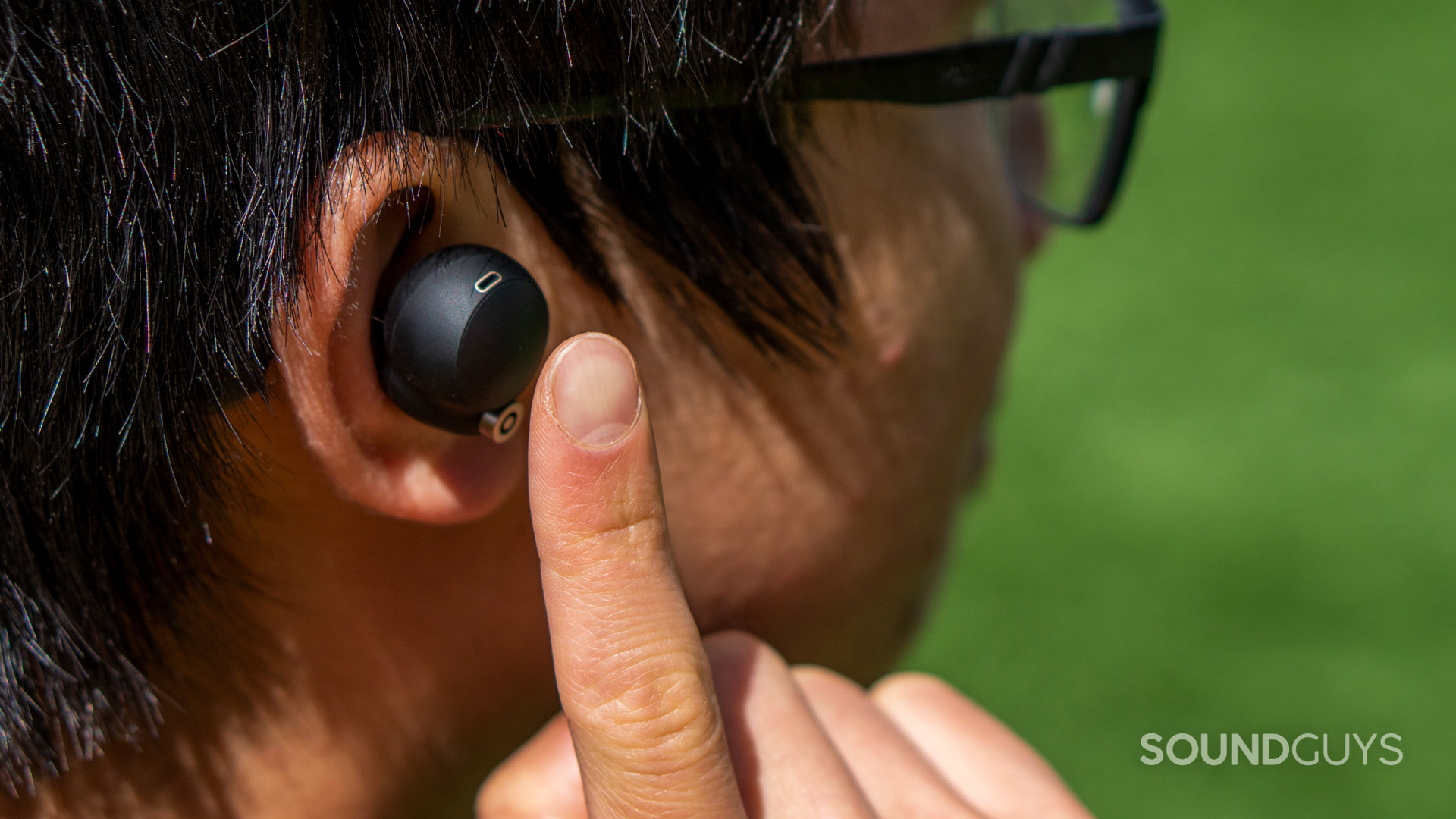
Both the Samsung Galaxy Buds Pro and Sony WF-1000XM4 wireless earbuds use touch controls, but Samsung’s panels are hyper-sensitive and often register misfires. We find Sony’s touch panels much more enjoyable to use.
Samsung Galaxy Buds Pro controls:
| INPUT | ACTION (left bud) | ACTION (right bud) |
|---|---|---|
| INPUT ONE TAP | ACTION (left bud) Play/Pause | ACTION (right bud) Play/Pause |
| INPUT TWO TAPS | ACTION (left bud) Next track Answer/end call | ACTION (right bud) Next track Answer/end call |
| INPUT THREE TAPS | ACTION (left bud) Skip to previous track Decline call | ACTION (right bud) Skip to previous track Decline call |
| INPUT TAP AND HOLD | ACTION (left bud) Volume down Reject call Toggle ANC/ambient modes (change in settings) | ACTION (right bud) Volume up Reject call Toggle ANC/ambient modes (change in settings) |
| INPUT "Hey, Bixby" | ACTION (left bud) Voice your request or inquiry (Samsung device only) | ACTION (right bud) Voice your request or inquiry (Samsung device only) |
Sony WF-1000XM4 controls:
| INPUT | ACTION (left bud) | ACTION (right bud) |
|---|---|---|
| INPUT ONE TAP | ACTION (left bud) Mute/ANC/Ambient sound | ACTION (right bud) Play/Pause |
| INPUT TWO TAPS | ACTION (left bud) N/A | ACTION (right bud) Track forward/answer call |
| INPUT THREE TAPS | ACTION (left bud) N/A | ACTION (right bud) Track backward |
| INPUT TAP AND HOLD | ACTION (left bud) N/A | ACTION (right bud) Smart assistant |
How do you connect the Samsung Galaxy Buds Pro and Sony WF-1000XM4 to a phone?
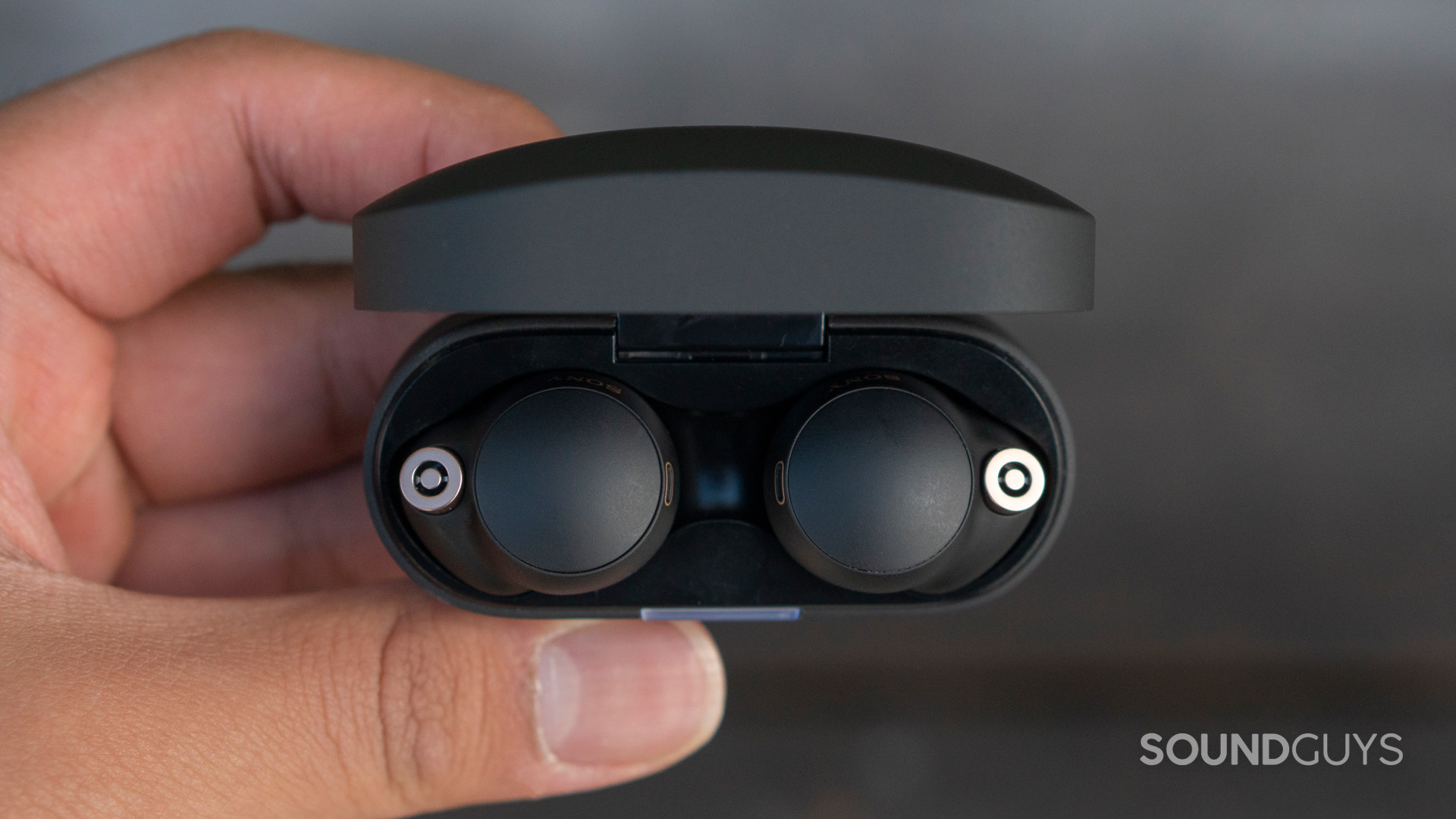
The newest Bluetooth version 5.2 is out, and the Sony WF-1000XM4 uses it. This latest version improves battery longevity and is compatible with all the mandatory Bluetooth codecs in the 5.2 stack, which includes the LE Audio codecs LC3 and LC3+, so you may see support for this in the future. These will replace the standard SBC default down the line. Most people will now use the Sony WF-1000XM4 with SBC, AAC, and LDAC codecs. LDAC is Sony’s high-quality Bluetooth codec, but it still can’t transmit lossless audio like wired headphones.
The Sony WF-1000XM4 is one of the first headsets to use Bluetooth 5.2.
The Samsung Galaxy Buds Pro is a little behind the game as it uses Bluetooth 5.0. This just means that compared to the Sony buds it won’t be quite as energy efficient and there’s no chance of LE Audio support. You can stream audio over the SBC, AAC, and the Samsung Scalable Codec, which is great for those with Samsung phones. The Galaxy Buds Pro doesn’t have Bluetooth multipoint, but you can switch between different Samsung Galaxy devices similarly, as long as they’re all associated with the same Samsung account.
Which pair of earbuds has better software features, Sony or Samsung?
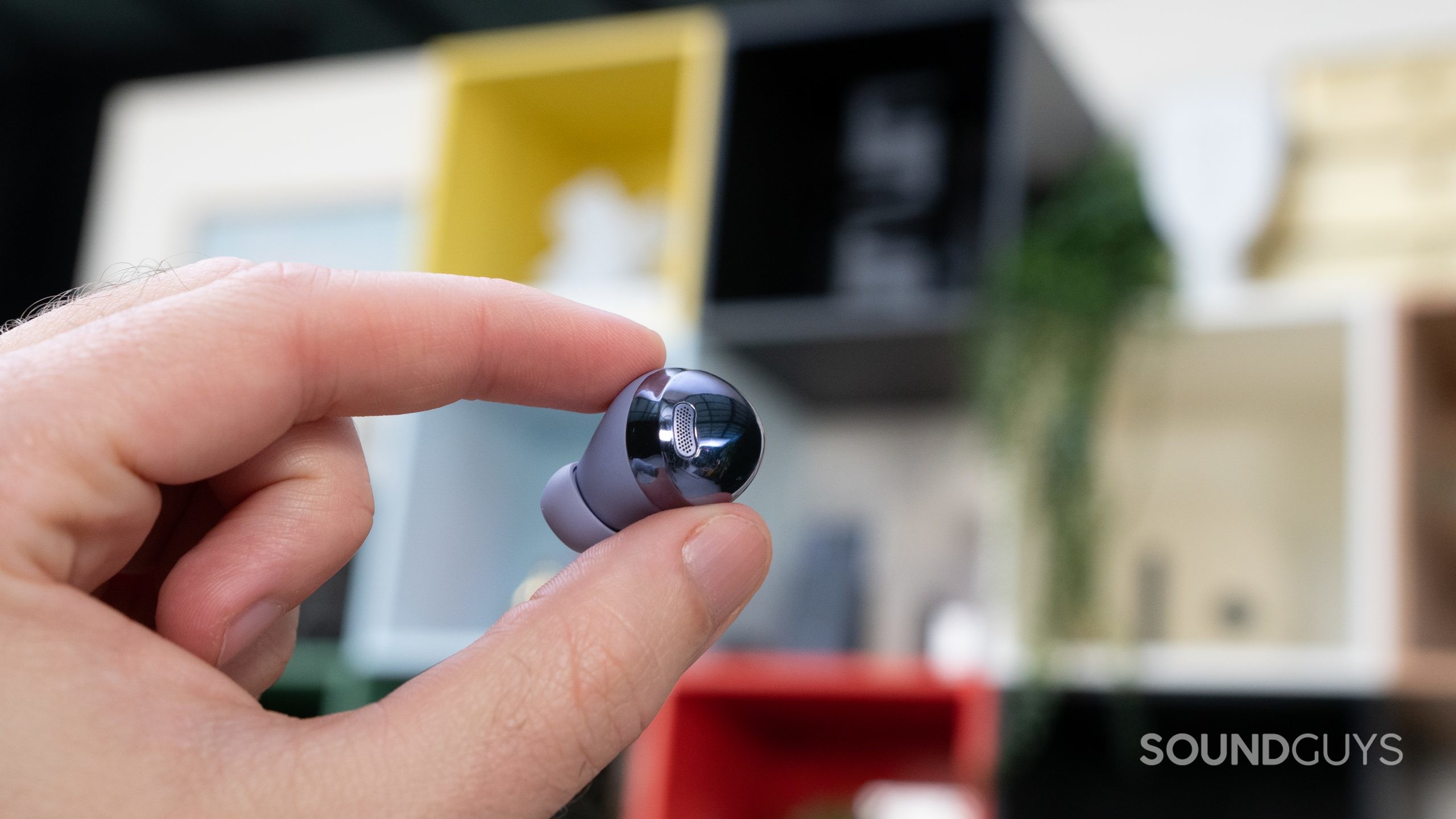
Besides the active noise canceling, the Sony WF-1000XM4 comes with a fair number of features, mostly available through the Sony Headphones Connect app (fully compatible with iOS or Android). With the app, you can remap the touch controls, select your smart assistant, and equalize the earbuds’ sound. These buds also support Sony’s 360 Reality Audio, which mimics the effects of a surround sound system, though it’s only compatible with streaming services like Tidal, Deezer, and nugs.
Holding down on the Sony WF-1000XM4 touchpad triggers a passthrough feature, so you can hear what’s happening around you. The headset also has Speak-to-Chat, which will automatically enable the passthrough feature someone starts talking. Some users find this feature annoying, and you can disable it in the companion app. There’s also an Automatic Wind Noise Reduction mode, and an Adaptive Sound Control setting that will recognize your frequently-visited locations to tailor the noise canceling experience.
Both headsets have companion apps that offer useful features.
The Samsung Galaxy Buds Pro has an app too, but its utility is limited to Android. The Samsung Galaxy Buds App on the Apple App Store doesn’t support the Galaxy Buds Pro. If you have an Android phone you can use the app to remap the touch controls or shut them off altogether. In addition, the app lets you enable ambient sound mode, equalize the frequency response, and toggle between two active noise canceling settings. The Galaxy Buds Pro also has a nearly identical feature to Sony’s 360 Reality Audio, called 360 Audio. It uses Dolby Atmos to create a 3D audio experience, and it can only be used when paired to a Samsung Galaxy device.
A nice accessibility feature included with Sony and Samsung’s buds is that you can use either of them to listen to music in mono. The Galaxy Buds Pro also has automatic voice detection which works just like the Sony buds’ Speak-to-Chat feature, and it can also be enabled and disabled at will.
Does the Samsung Galaxy Buds Pro or Sony WF-1000XM4 have better battery?
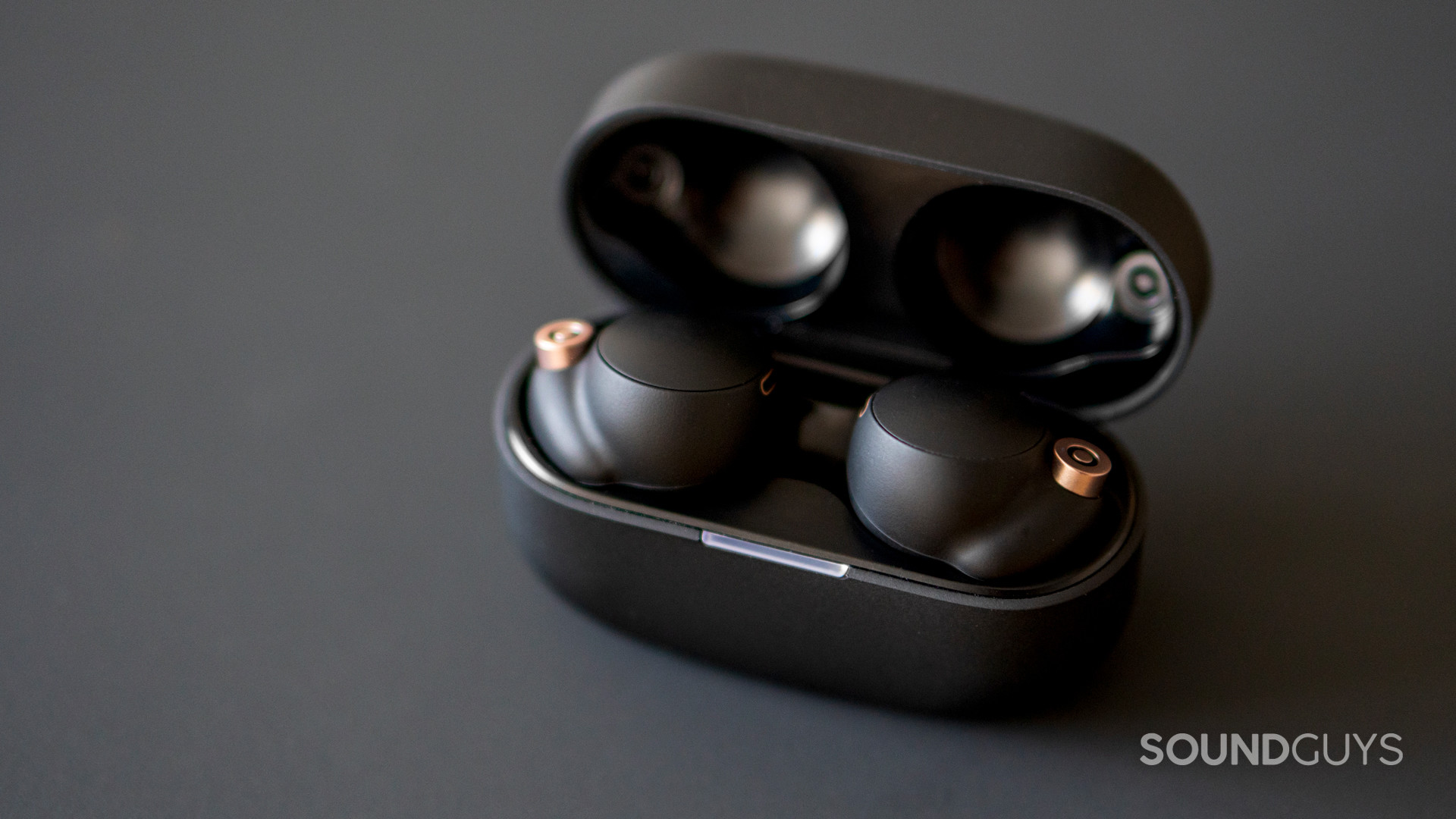
The Sony WF-1000XM4 has a great battery life for a pair of true wireless earbuds — with active noise canceling enabled, it lasts 7 hours, 43 minutes on a single charge. The case holds two additional charge cycles as well, and plugging the buds in for 5 minutes will give you 60 minutes of listening time. The USB-C case is also compatible with Qi-wireless charging.
The Galaxy Buds Pro also has wireless charging and its case holds an additional 13 hours of juice. Performing the same standardized test the buds last for 4 hours, 48 minutes on a single charge with active noise canceling enabled. They are sure to last a bit longer if you’re not using ANC. Like Sony’s case, the Galaxy Buds Pro case supports USB-C and wireless charging. It has an extra trick up its sleeve: Samsung Wireless PowerShare, which charges the case when placed atop a compatible Samsung device.
Which headset has better active noise canceling?
Loading chart ...
Thanks to the memory foam ear tips that come with the Sony WF-1000XM4, it already has a leg up on its isolation and standardized test, particularly in the higher frequencies. Add on the crazy-effective active noise canceling, and you’re practically blocking out all sounds. The ANC reduces the volume of ambient noise by one-quarter to one-sixteenth as loud as it is in reality. It would be nice if the Sony Headphones Connect app let you toggle between different levels of ANC, but there’s always ambient sound mode.
Loading chart ...
Though the isolation isn’t quite as guaranteed with the Samsung Galaxy Buds Pro due to its silicone ear tips, it still functions well. Achieving a proper fit with your earbuds is really important for maximizing the active noise canceling performance. Assuming you can get a good seal, the Galaxy Buds Pro’s active noise canceling works well, quieting low frequencies by about three-fold on the highest ANC setting. You can toggle between the two settings in the app, and you may want to use the lower setting to remain safe when in public. The lower setting attenuates midrange frequencies decently, and the high setting’s forte is lower frequencies.
Samsung Galaxy Buds Pro vs Sony WF-1000XM4: Which earbuds sound best?
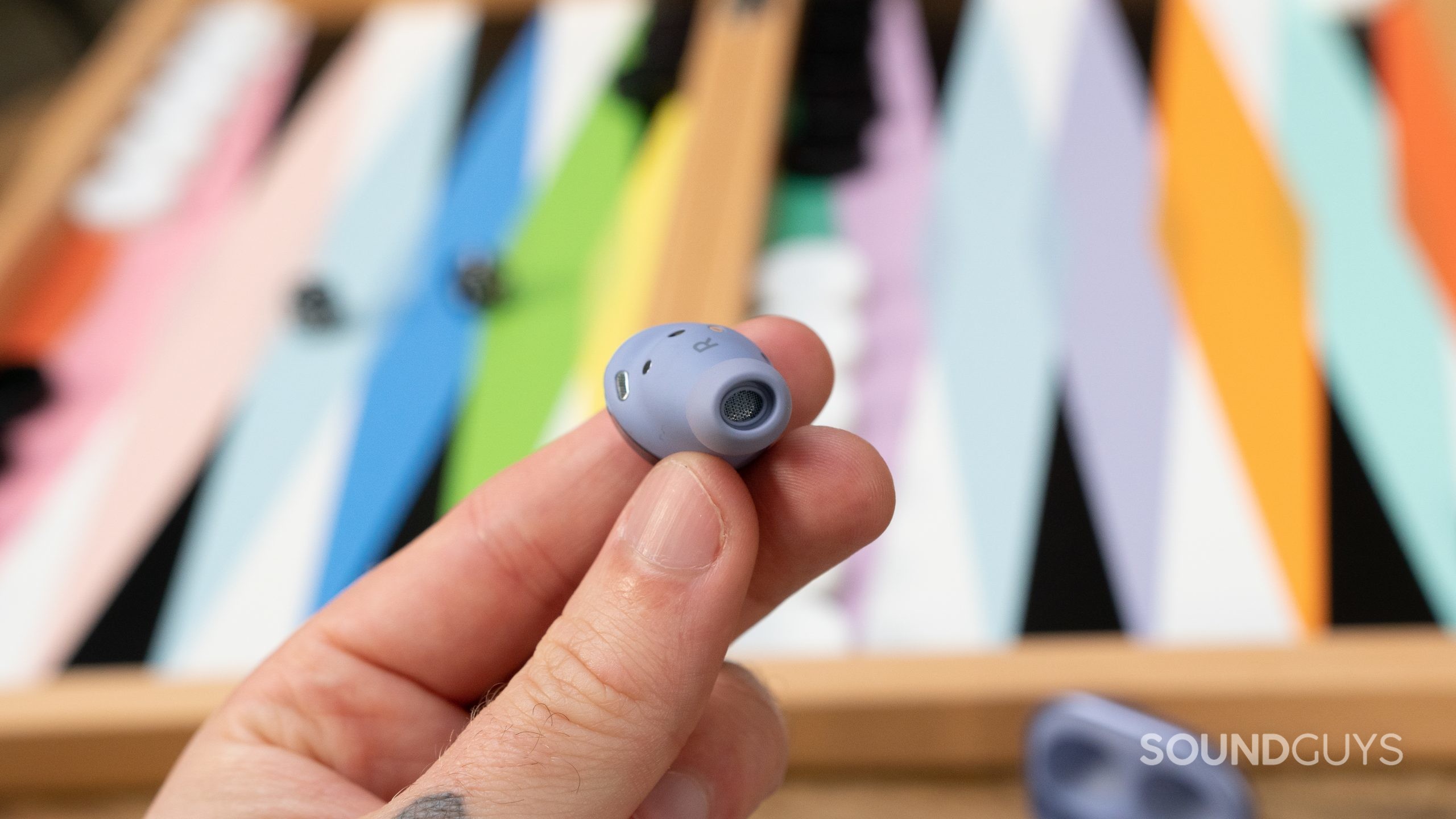
The Sony WF-1000XM4 sounds pretty good, but the bass frequencies are emphasized and treble notes are under-emphasized quite a bit. The high-frequency attenuation makes it hard to hear detail from your music like guitar and vocal harmonics. If you don’t like this frequency response, you can equalize it in the Headphones Connect app. The WF-1000XM4 also has a version of Sony’s digital sound enhancement engine (DSEE), called DSEE Extreme, which upsamples lossy tracks to slightly improve the quality of low-resolution audio files.
Loading chart ...
The Samsung Galaxy Buds Pro sounds close to our target curve and relays music closely to how musicians and producers intend it to sound. You can always select from the EQ presets in the Galaxy Wearable app to boost the bass, treble, or other frequencies. Explore the different options to figure out which one you like best. You won’t be able to manually set your equalizer, but the presets offer a good range of options.
Does the Sony WF-1000XM4 have a better mic for phone calls than the Samsung Galaxy Buds Pro?
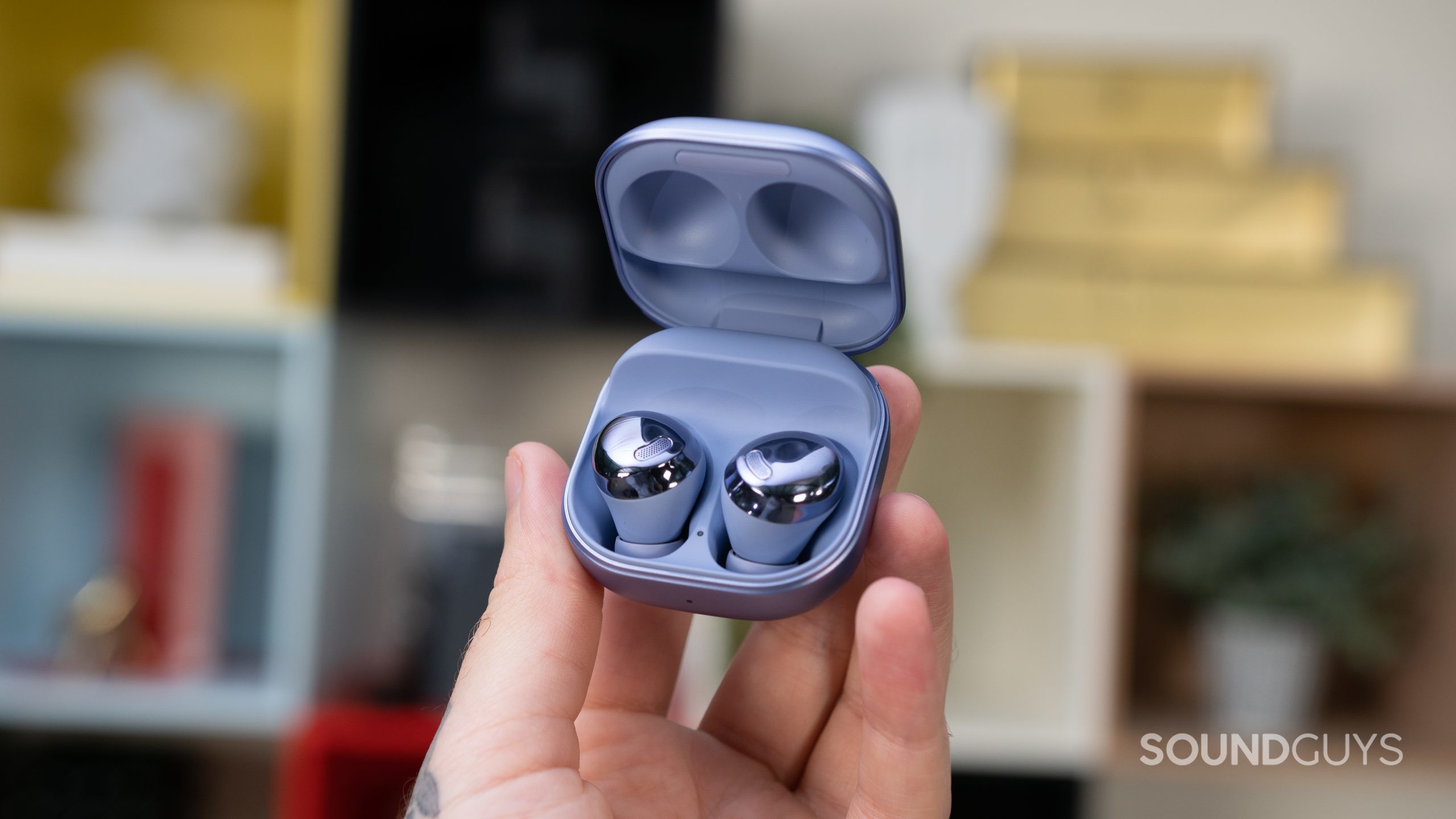
The mic on the Sony WF-1000XM4 is pretty good, and it uses a bone conduction sensor to more accurately recognize when you’re talking. It can detect when you’re speaking and boost your voice while quieting the environmental noise around you, though it’s still nothing phenomenal. It can sometimes struggle in the face of office noises or wind. The same is true for the Samsung Galaxy Buds Pro — it does a good job of dulling ambient sound and picks up voices pretty well regardless of their pitch with its neutral mic frequency response. It has a decent off-axis noise rejection.
Sony WF-1000XM4 microphone demo (Ideal conditions):
Sony WF-1000XM4 microphone demo (Office conditions):
Samsung Galaxy Buds Pro microphone demo (Ideal conditions):
Samsung Galaxy Buds Pro microphone demo (Office conditions):
Which microphone sounds better to you?
Which headset should you buy, the Samsung Galaxy Buds Pro or Sony WF-1000XM4?
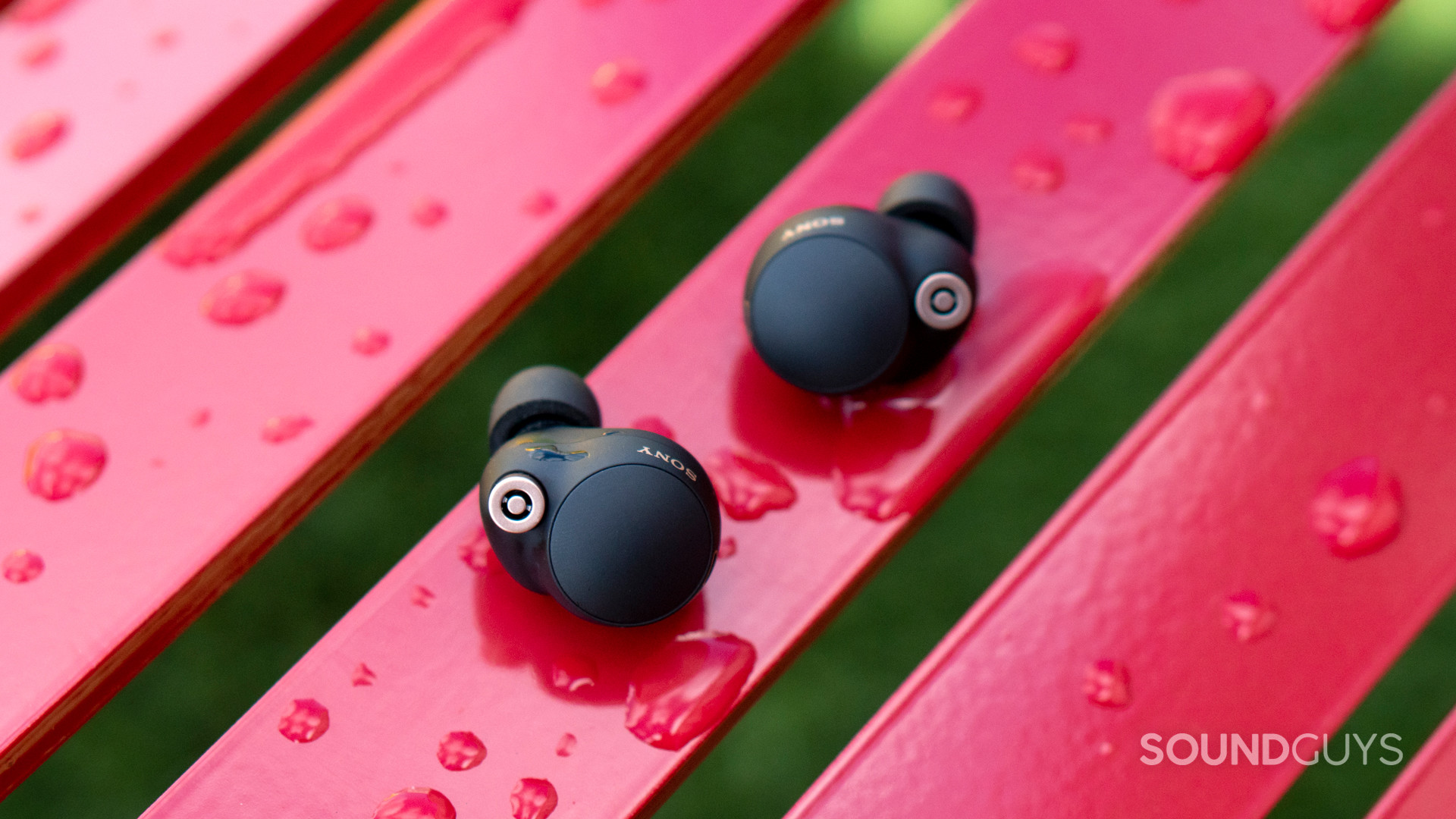
The Samsung Galaxy Buds Pro is discontinued now, so between these two earphones, you’re better off with the Sony WF-1000XM4 for continued device support. With the WF-1000XM4 you get features like 360 Reality Audio, premium build quality, and the ear tip fit test. It is also one of the first headsets to offer Bluetooth 5.2, and it has a far better battery life than the Samsung buds, but don’t dismiss the Samsung Galaxy Buds Pro just yet (if you can find them).
The Samsung Galaxy Buds Pro is tougher (with its IPX7 rating) and has more flexibility regarding ANC compared to the Sony WF-1000XM4. Oh, it’s also more affordable, cancels noise well, and its sound signature requires less tinkering. These buds also have 360 Audio, and the slightly older Bluetooth 5.0 is nothing to scoff at; it just isn’t brand new. Anyone who doesn’t need the newest toy on the market will be more than satisfied with the Samsung Galaxy Buds Pro. If you can find the Galaxy Buds Pro, it’s heavily discounted these days.

Impressive microphone performance
Wireless charging

What should you get instead of the Sony and Samsung earbuds?
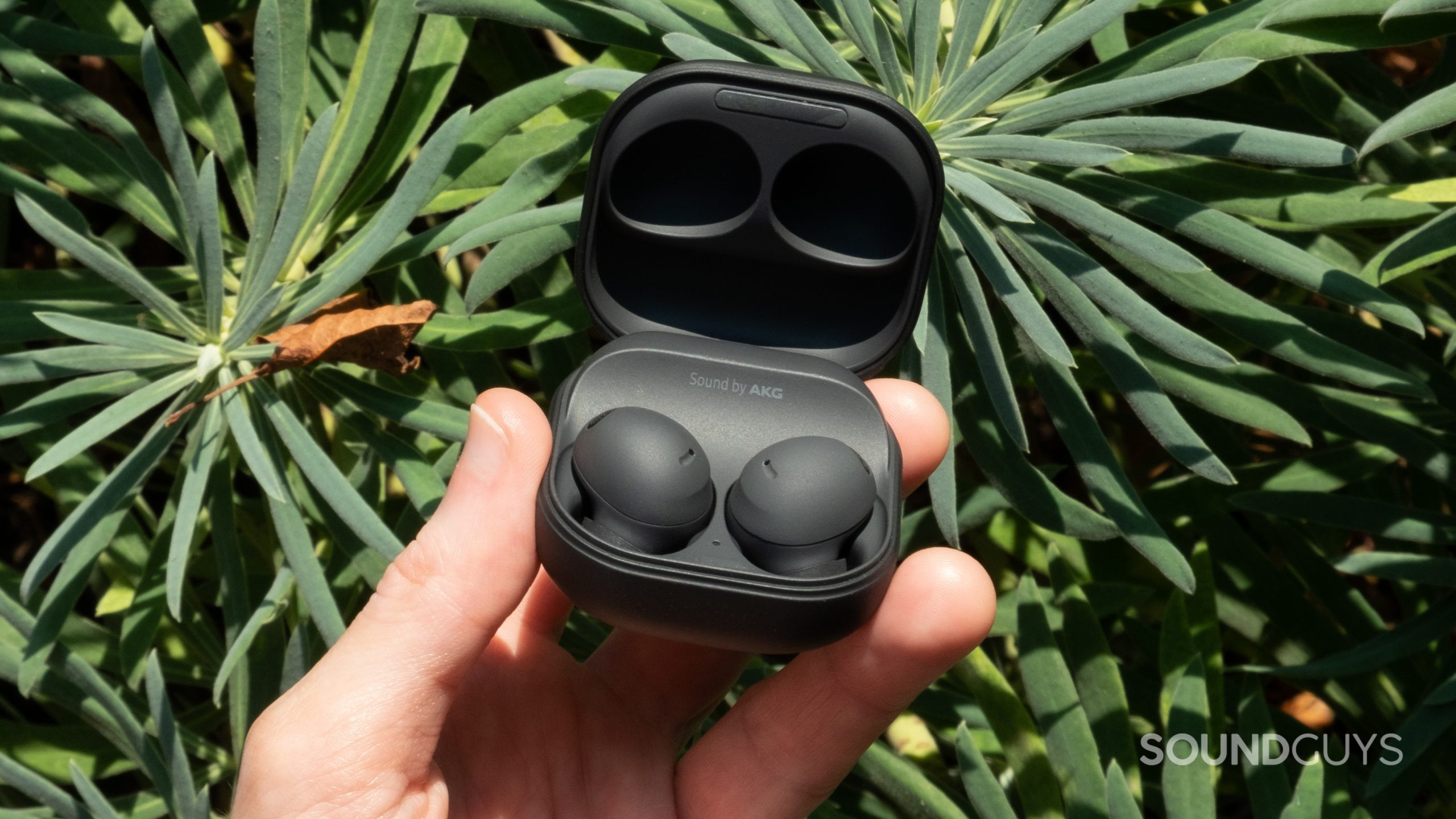
Those who don’t want to hunt for a bargain on a discontinued product like the Samsung Galaxy Buds Pro should get the Samsung Galaxy Buds 2 Pro instead for $179 at Amazon. Compared to the Buds Pro, the Buds 2 Pro has better noise canceling, more pleasantly responsive touch controls, and nearly identical battery life. We like that Samsung kept the IPX7 rating of the Galaxy Buds Pro when making the Galaxy Buds 2 Pro. Unlike before, the Galaxy Buds 2 Pro housings are a rubberized matte plastic which is easier to grip than the glossy housings of yesteryear.
The best option for iPhone users remains the Apple AirPods Pro (2nd generation). With these wireless earbuds, you get much better active noise canceling than before, a more robust case with an IPX4 rating, and the same seamless UI when paired with Apple devices. Of course, if you don’t want to pay the Apple tax, there are plenty of alternatives, but you can grab the AirPods Pro (2nd generation) for $239 at Amazon.
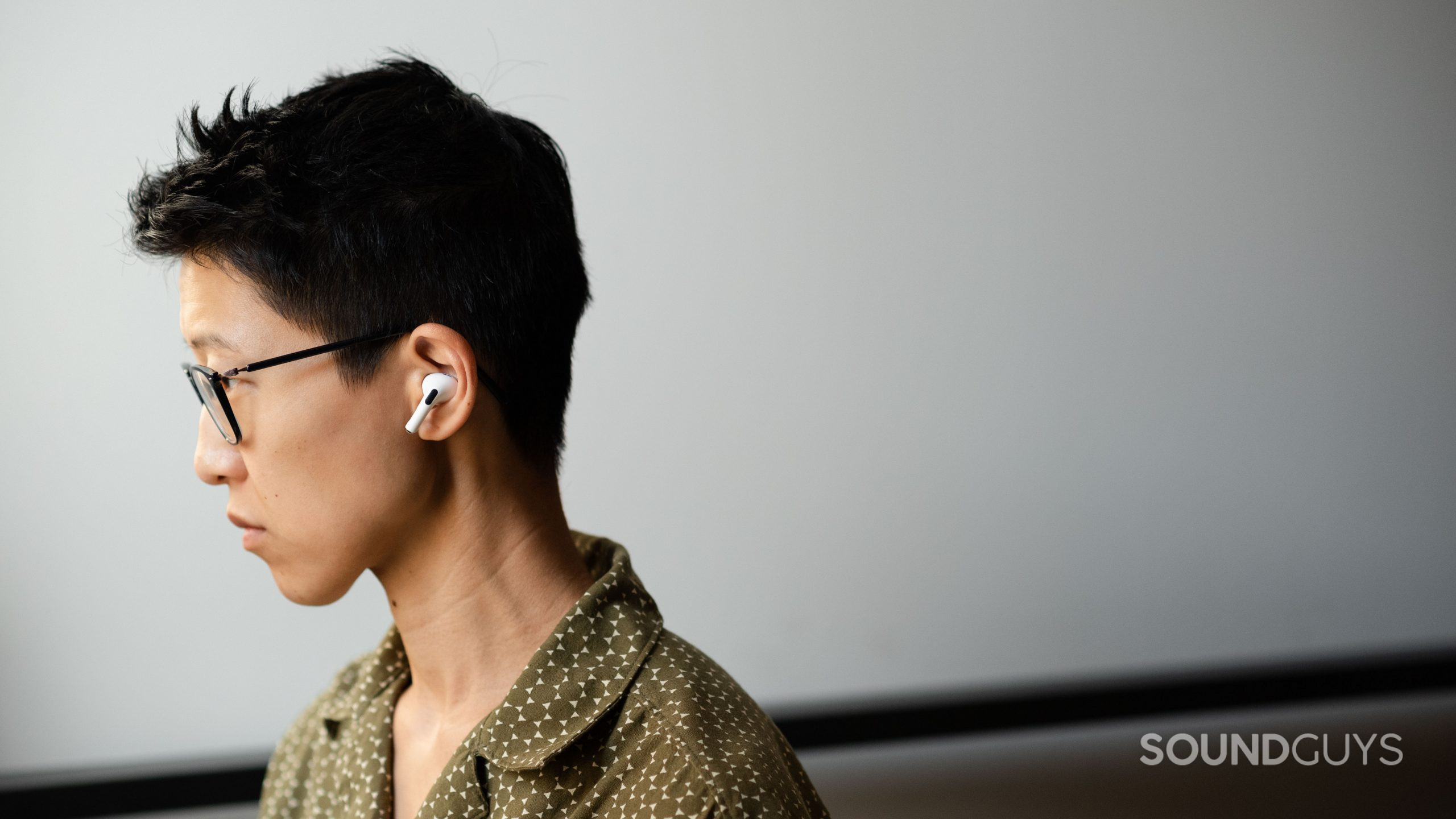
Finally, for productivity minded folks, especially those possessing Android phones, the Google Pixel Buds Pro has a bevvy of futuristic features, such as a translate tool to translate speech on the fly. You may see it stacks up to the Sony WF-1000XM4 and it’s worth consideration. For $199 at Amazon you might want to give it a look too.
Of course, the Sony WF-1000XM5 stands as an upgrade to the WF-1000XM4. They’re pricey ($298 at Amazon), but are smaller than the last generation, with excellent isolation and battery life. They’re definitely flagship earbuds.
Frequently asked questions about Samsung Galaxy Buds Pro vs Sony WF-1000XM4
Like a lot of specifications lists, the real determinant is real life use. So, for iPhone users if you’ve got AAC codec supported, that’s about all you need. Basically your codec determines the ceiling of capabilities, but when it’s a variable rate, it’s hard to say how it’ll perform. LDAC has a greater maximum data transfer capability compared to Samsung Scalable Codec, but we can’t know which performs best for you because of the variables that influence connection and transfer.
Otherwise, the WF-1000XM4 inclusion of LDAC has a very high potential data transfer rate, however, if your connection is wonky (due to any number of variables, from connection stability down to the phone itself) it’ll reduce the quality. You’ll have to go through the Sony Headphones app to make priority selections. Similarly, the Samsung Scalable Codec is a proprietary version of the same principle, only exclusive between Samsung devices.
It’s true that the Sony WF-1000XM3 when released, was a pretty good set of true wireless earbuds, but these days there are plenty of updated alternatives. If your main concern is noise canceling, get the Samsung Galaxy Buds Pro. However, both are quite outdated now.
We’ve compared the Samsung Galaxy Buds 2 with the Sony WF-1000XM4 and the Samsung Galaxy Buds Pro. It’s cheaper than both, so it’s worth asking yourself what you need and what you don’t. The ANC performs very similarly to the Galaxy Buds Pro on the Galaxy Buds 2. Meanwhile, the Galaxy Buds 2 has a battery life that falls in between the longer lasting WF-1000XM4 and the shorter, Galaxy Buds Pro. By default it sounds pretty similar to the Samsung Galaxy Buds Pro. Smaller ears might find the Galaxy Buds 2 fit best. The IPX2 found on the Samsung Galaxy Buds 2 makes it the least durable of the three. Besides battery life and the IP rating difference, you’re splitting hairs with the two Samsung buds.